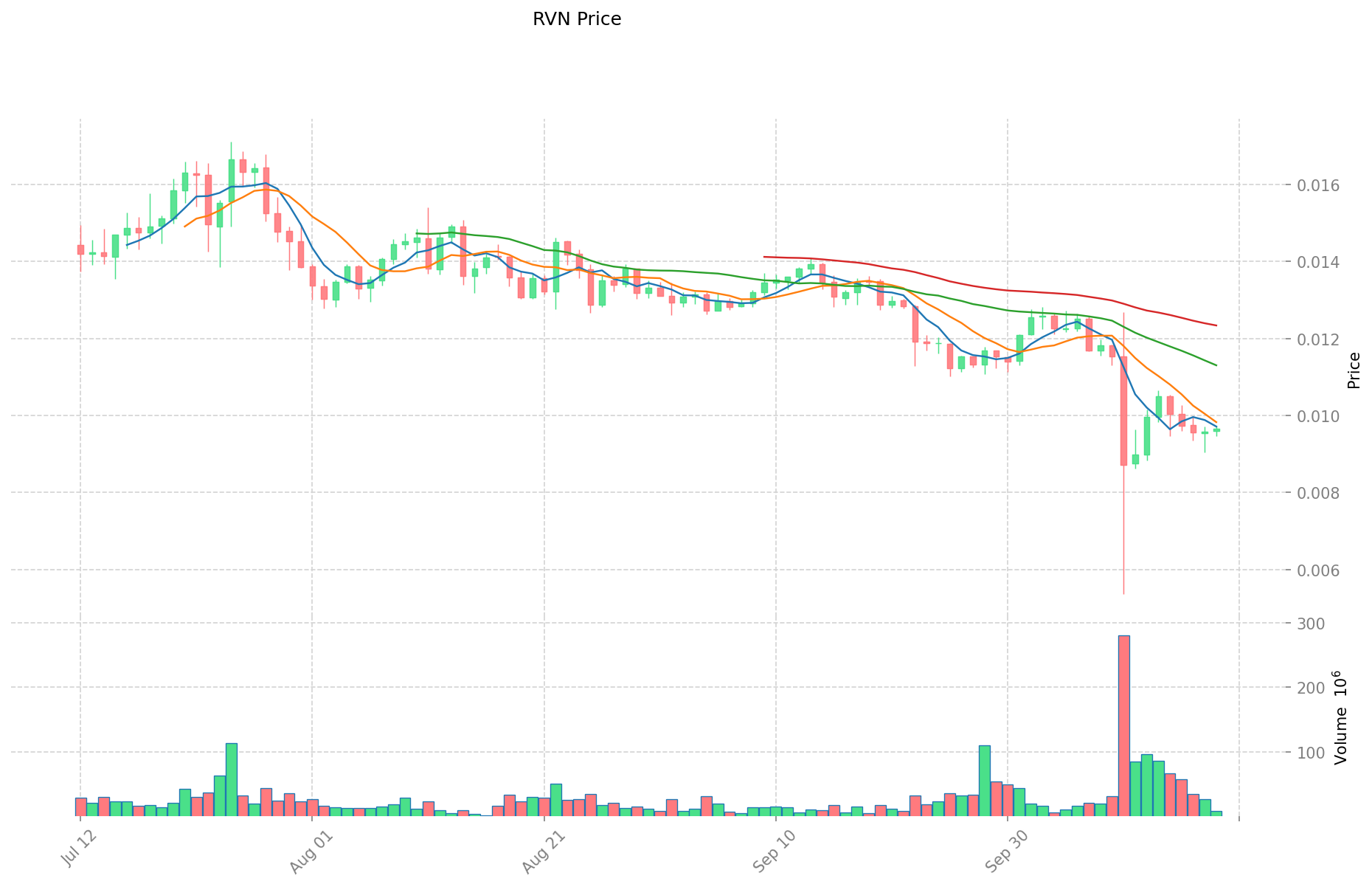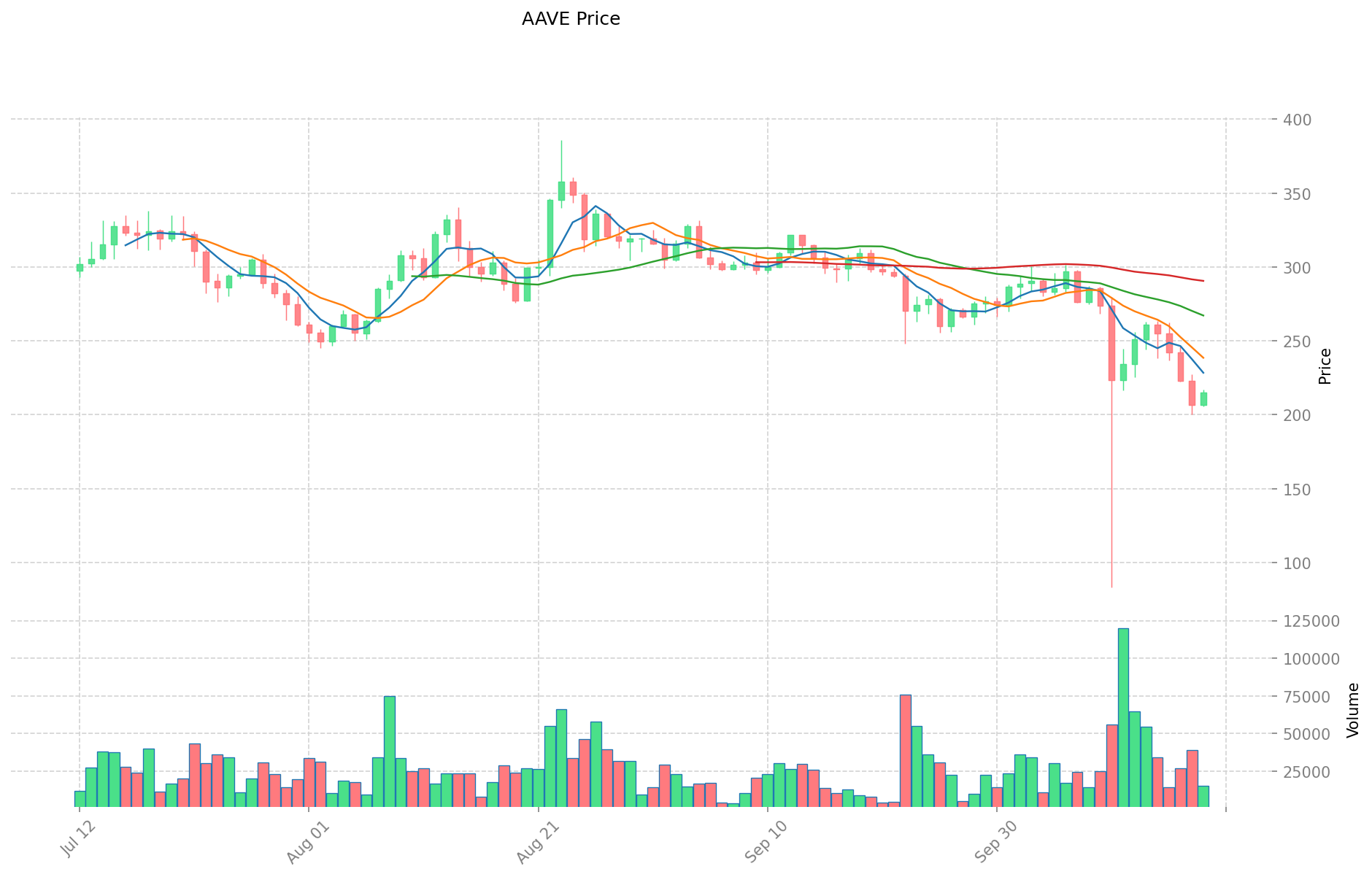RVN vs AAVE: Which Crypto Asset Offers Better Long-Term Growth Potential?
Introduction: RVN vs AAVE Investment Comparison
In the cryptocurrency market, the comparison between Ravencoin (RVN) and AAVE has been an unavoidable topic for investors. The two not only show significant differences in market cap ranking, application scenarios, and price performance, but also represent different positions in the crypto asset space.
Ravencoin (RVN): Since its launch in 2018, it has gained market recognition for its focus on transferring assets from one party to another efficiently.
AAVE (AAVE): Introduced in 2020, it has been hailed as a leading decentralized lending protocol, providing deposit and lending services to users.
This article will provide a comprehensive analysis of the investment value comparison between RVN and AAVE, focusing on historical price trends, supply mechanisms, institutional adoption, technological ecosystems, and future predictions, attempting to answer the question investors care about most:
"Which is the better buy right now?"
I. Price History Comparison and Current Market Status
RVN and AAVE Historical Price Trends
- 2021: RVN reached its all-time high of $0.285218 on February 20, 2021.
- 2020: AAVE was launched on October 3, 2020, through the conversion of LEND tokens at a ratio of 100:1.
- Comparative analysis: Since their respective peaks, RVN has declined to a current price of $0.009619, while AAVE is currently trading at $214.14.
Current Market Situation (2025-10-19)
- RVN current price: $0.009619
- AAVE current price: $214.14
- 24-hour trading volume: $90,853.14 (RVN) vs $3,153,101.98 (AAVE)
- Market Sentiment Index (Fear & Greed Index): 23 (Extreme Fear)
Click to view real-time prices:
- View RVN current price Market Price
- View AAVE current price Market Price


II. Core Factors Affecting RVN vs AAVE Investment Value
Supply Mechanism Comparison (Tokenomics)
-
RVN: Limited maximum supply of 21 billion tokens with a halving mechanism similar to Bitcoin (every 4 years)
-
AAVE: Total supply of 16 million tokens with a deflationary mechanism through token burns from protocol fees
-
📌 Historical Pattern: RVN's halving events historically create supply constraints that can lead to cyclical price movements, while AAVE's deflationary model gradually reduces circulating supply as network activity increases.
Institutional Adoption and Market Applications
- Institutional Holdings: AAVE has gained more institutional adoption, being integrated into major DeFi portfolios and institutional lending platforms
- Enterprise Adoption: AAVE leads in financial applications with its lending protocol being used by various crypto projects, while RVN's asset tokenization capabilities have seen more limited commercial implementation
- Regulatory Stance: AAVE faces increased regulatory scrutiny as a DeFi protocol, while RVN's focus on asset tokenization positions it differently in various regulatory frameworks
Technical Development and Ecosystem Building
- RVN Technical Upgrades: Recent focus on scalability improvements and enhanced asset tokenization features
- AAVE Technical Development: Continuous protocol iterations including V3 release with improved capital efficiency and risk management features
- Ecosystem Comparison: AAVE has a robust DeFi ecosystem with multiple integrations across lending, borrowing and yield strategies, while RVN's ecosystem focuses primarily on asset tokenization and mining
Macroeconomic Factors and Market Cycles
- Performance in Inflationary Environments: RVN shares some store-of-value properties with Bitcoin due to its fixed supply cap, while AAVE's value is more tied to DeFi activity
- Macroeconomic Monetary Policies: Rising interest rates typically pressure both assets, though AAVE may benefit from increased DeFi yields
- Geopolitical Factors: Cross-border transaction needs can benefit both assets, with RVN potentially serving as an alternative in regions with currency restrictions
III. 2025-2030 Price Prediction: RVN vs AAVE
Short-term Prediction (2025)
- RVN: Conservative $0.00568 - $0.00963 | Optimistic $0.00963 - $0.01251
- AAVE: Conservative $199.31 - $214.31 | Optimistic $214.31 - $222.88
Mid-term Prediction (2027)
- RVN may enter a growth phase, with expected prices ranging from $0.00735 to $0.01482
- AAVE may enter a consolidation phase, with expected prices ranging from $196.93 to $277.73
- Key drivers: Institutional capital inflow, ETF, ecosystem development
Long-term Prediction (2030)
- RVN: Base scenario $0.01168 - $0.01915 | Optimistic scenario $0.01915 - $0.02738
- AAVE: Base scenario $251.41 - $392.83 | Optimistic scenario $392.83 - $510.68
Disclaimer: The information provided is for informational purposes only and should not be considered as financial advice. Cryptocurrency markets are highly volatile and unpredictable. Always conduct your own research before making any investment decisions.
RVN:
| 年份 | 预测最高价 | 预测平均价格 | 预测最低价 | 涨跌幅 |
|---|---|---|---|---|
| 2025 | 0.0125138 | 0.009626 | 0.00567934 | 0 |
| 2026 | 0.013837375 | 0.0110699 | 0.008523823 | 15 |
| 2027 | 0.014819828625 | 0.0124536375 | 0.007347646125 | 29 |
| 2028 | 0.018409589634375 | 0.0136367330625 | 0.010500284458125 | 41 |
| 2029 | 0.022272194274328 | 0.016023161348437 | 0.014260613600109 | 66 |
| 2030 | 0.027381179270277 | 0.019147677811382 | 0.011680083464943 | 99 |
AAVE:
| 年份 | 预测最高价 | 预测平均价格 | 预测最低价 | 涨跌幅 |
|---|---|---|---|---|
| 2025 | 222.8824 | 214.31 | 199.3083 | 0 |
| 2026 | 286.361022 | 218.5962 | 111.484062 | 2 |
| 2027 | 277.7264721 | 252.478611 | 196.93331658 | 17 |
| 2028 | 368.4925327545 | 265.10254155 | 180.269728254 | 23 |
| 2029 | 468.86035498533 | 316.79753715225 | 231.2622021211425 | 47 |
| 2030 | 510.677629889427 | 392.82894606879 | 251.4105254840256 | 83 |
IV. Investment Strategy Comparison: RVN vs AAVE
Long-term vs Short-term Investment Strategies
- RVN: Suitable for investors focused on asset tokenization potential and mining
- AAVE: Suitable for investors interested in DeFi yields and protocol revenue
Risk Management and Asset Allocation
- Conservative investors: RVN: 20% vs AAVE: 80%
- Aggressive investors: RVN: 40% vs AAVE: 60%
- Hedging tools: Stablecoin allocation, options, cross-currency portfolios
V. Potential Risk Comparison
Market Risks
- RVN: Higher volatility, lower liquidity
- AAVE: DeFi market fluctuations, competitive pressure
Technical Risks
- RVN: Scalability, network stability
- AAVE: Smart contract vulnerabilities, protocol upgrades
Regulatory Risks
- Global regulatory policies have different impacts on both assets, with AAVE facing more scrutiny in the DeFi space
VI. Conclusion: Which Is the Better Buy?
📌 Investment Value Summary:
- RVN advantages: Fixed supply cap, asset tokenization focus
- AAVE advantages: Established DeFi protocol, institutional adoption
✅ Investment Advice:
- New investors: Consider a smaller allocation to AAVE as part of a diversified portfolio
- Experienced investors: Balanced approach with both assets, tilting towards AAVE
- Institutional investors: AAVE may be more suitable due to its established position in DeFi
⚠️ Risk Warning: Cryptocurrency markets are highly volatile. This article does not constitute investment advice. None
VII. FAQ
Q1: What are the main differences between RVN and AAVE? A: RVN focuses on asset tokenization and has a fixed supply cap, while AAVE is a decentralized lending protocol in the DeFi space with a deflationary token model.
Q2: Which cryptocurrency has shown better price performance historically? A: AAVE has shown better price performance, currently trading at $214.14 compared to RVN's $0.009619. AAVE has also maintained a higher price level since its launch.
Q3: How do the supply mechanisms of RVN and AAVE differ? A: RVN has a limited maximum supply of 21 billion tokens with a halving mechanism, while AAVE has a total supply of 16 million tokens with a deflationary mechanism through token burns.
Q4: Which cryptocurrency has gained more institutional adoption? A: AAVE has gained more institutional adoption, being integrated into major DeFi portfolios and institutional lending platforms.
Q5: What are the key factors affecting the future price of RVN and AAVE? A: Key factors include institutional capital inflow, potential ETF approvals, ecosystem development, regulatory changes, and overall market sentiment in the crypto space.
Q6: How do the long-term price predictions for RVN and AAVE compare? A: By 2030, RVN is predicted to reach $0.01168 - $0.02738, while AAVE is expected to reach $251.41 - $510.68 in the base and optimistic scenarios respectively.
Q7: What are the main risks associated with investing in RVN and AAVE? A: RVN faces higher volatility and lower liquidity risks, while AAVE is exposed to DeFi market fluctuations and competitive pressure. Both face technical and regulatory risks to varying degrees.
Share
Content